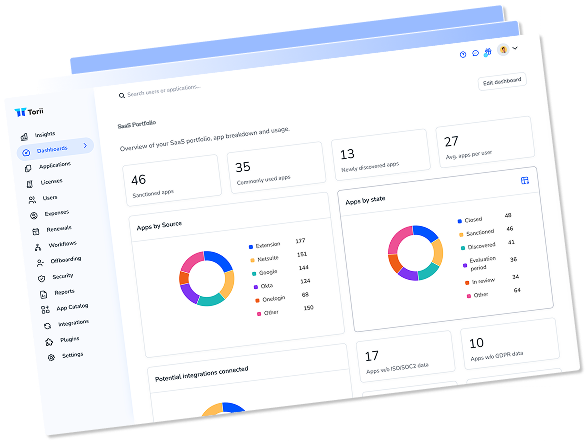Cloud Application Security—you’ve heard of it, probably have been told that you need it, but what does it really mean?
What is Cloud Application Security?
Cloud Application Security is the practice of securing your company’s data, infrastructure, and (you guessed it!) applications that are involved in cloud computing (any data that is not hosted on-premise).
If you’re unfamiliar with Cloud Application Security, you may think these features sound like nice-to-haves, not need-to-haves, or that they sound eerily similar to the promises made by traditional security platforms.
However, to really understand the importance of Cloud Application Security, you need to know what’s at risk and how it will protect you.
Why do you need Cloud Application Security?
It’s hard to imagine a world without apps—those helpful little tools that seem to solve every problem we encounter. We owe this reality, in part, to the Saas explosion that started in the early 2000s. Thanks to this explosion, employees regularly download, swap out, and experiment with applications to find creative ways to streamline their workflow.
In fact, most organizations:
- Have 300-600 cloud apps in use across various teams
- Add 15-25 new apps to the mix every month (that’s 180-300 new apps per year!)
- Procure apps outside of IT 75% of the time
- Swap up to 50% of their app tech stack every two years
And who can blame them? Hundreds of apps are practically begging to be used. All that’s needed is a corporate email and the will to fill out a trial form and, just like that, an employee has access to freemium software that easily integrates with G-suite, Hubspot, or Slack…
But, that’s the problem.
Our security implementations have not kept up! While many organizations have implemented some form of security (SSO, CASB tool, Firewall, Anti-malware…), cloud apps often sidestep the traditional tools of IT departments, posing a serious security threat to sensitive data.
What’s more, IT managers are still on the hook for all things security-related. This creates an ever-growing problem—the rise of Shadow IT.
Featured Video: What is Shadow IT? [Explainer]
The “obvious” solution may appear to be implementing a locked-down-red-tape-covered process of application review and approval. But, let’s be honest, the amount of time, manual labor, and consequential bottlenecks that come with this level of control doesn’t work for many organizations.
Even if it did, it may not be in your company’s best interest to squash the creativity and ingenuity of your employees.
Note 💡: In a study conducted by Penn Schoen Berland (PSB) 42% of millennials said they would leave a company due to “substandard technology.”
So, how can IT departments manage, support, and protect their company’s data when they don’t have full insight into how it’s being used? Well, they can’t… not without the proper tools, that is.
That’s where Cloud Application Security comes in.
How Cloud Application Security Protects Your Sensitive Data
It’s important to note, adopting Cloud Application Security is not about buying a specific tool. It’s larger than that. Cloud Application Security is a change in thinking, a state of being for your organization. It’s about equipping your company with the level of automation and visibility needed to quickly and effectively remove threats and prevent them from ever arising.
But how?
Automation
Human error was the cause of approximately 90 percent of data breaches in 2019.1 Speaking as a human, that’s not a great look!
The best way to improve Cloud Application Security is to remove unnecessary manual processes. For example, Automated Saas Management Systems quickly identify and report when a user adds an unsanctioned app to a company’s tech stack, protecting your company’s sensitive data by removing the threat of Shadow IT.
In fact, Torii automatically discovers 2x the number of apps as other SaaS Management systems making it a critical part of any Cloud Application Security plan.
Additionally, Cloud Application Security automates processes like deprovisioning and offboarding that contribute to security risks and consume valuable employee time.
Visibility
Traditionally, there has been a shroud of darkness veiling apps from IT’s sight. But, to achieve Cloud App Security, IT needs to have visibility into application usage data. Not simply how the tool is used, but also if it is used at all!
Think about it, nothing would be worse than exposing your sensitive data in an app that nobody uses and 35% of app licenses are wasted.
That’s why it’s important to recognize which applications are essential, and which ones are a risk waiting to happen. By removing unused apps and deprovisioning unused licenses, your company reduces the number of channels through which your sensitive data is exposed.
Bonus: Your company also reaps the benefits of trimming hidden Saas costs!
Take Back Control of Your Security
It’s obvious that apps aren’t going away any time soon — they’re a natural, useful, yet dangerous extension to how companies operate today. But, in order to be prepared for these new security risks, your company needs new security measures—Cloud Application Security.
If you’re ready to take back control of your cloud Application security, consider learning more about Saas Management and how Torii can help protect your sensitive data.
Data Referenced:
1. https://www.venafi.com/blog/7-data-breaches-caused-human-error-did-encryption-play-role
![What is Cloud Application Security? [And Why Does It Matter?]](https://www.toriihq.com/wp-content/uploads/2022/02/cloud-app-security.png)
